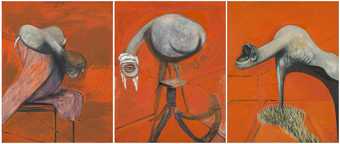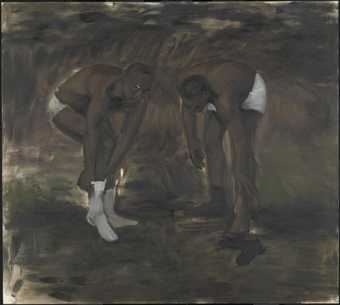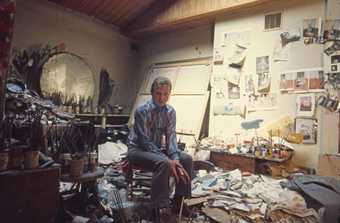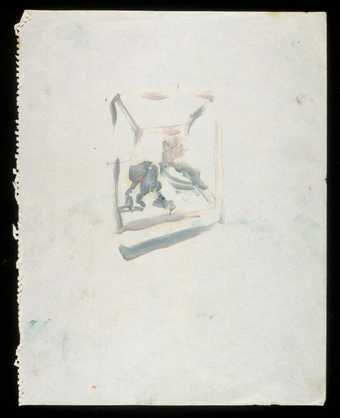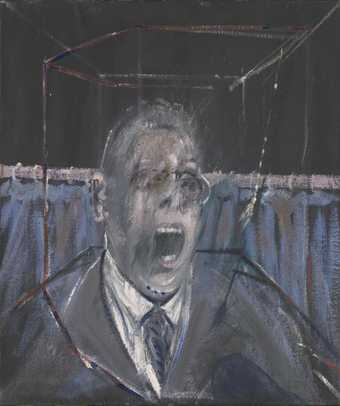Scottee: Soho, the B and Ha of London’s West End. A playground of hedonism, of culture and of art. A place that push boundaries and in turn, drawing some of the country’s most iconic artists, with its seedy underbelly and faded glamour, amid which many artists found themselves when fame and wealth failed to materialize. My name is Scottee and Soho has always held a very special place in my heart. I cut my teeth as a performance artist, an artist and even a drag queen.
Today, we’re taking a walk around Soho’s artistic past. Going around some of the pubs, the drinking clubs, restaurants, night clubs and member’s clubs, which took Soho’s artists from breakfast to bed. I’m going to be meeting Tate curators and veterans of the 1950s Soho scene along the way.
[music]
Man 1: Because we have to do something every day. [laughs] get you some more flower. This is my flower.
Scottee: We’re on Dean Street, this is sort of the heart of Soho. It’s right bang in the middle of it and we’re outside the French House. It does feel like a place where you got to know the secret handshake to get in, so we’ll see how this goes. Art historian, Michael Peppiatt, was a polo-necked student when he first came here, to the French House. He was on an assignment for a student magazine to interview the painter Francis Bacon. A few bottles of wine and a few years later, Michael became Bacon’s good friend and biographer.
Michael Peppiatt: I was studying the history of art, I wanted to do something modern of my own time in the early ‘60s. Somebody said to me, “Well, you should talk to Francis Bacon. He’s just had a show, a big exhibition, a retrospect to the Tate. He’s the most interesting painter in England now.” I found out a bit about him and through this friend whose mother had been photographed by John Deakin. I met John Deakin just over there by the beer pumps.
John Deakin said, “Well, my dear, I don’t know whether you could meet the great painter now that she’s become so famous, so famous.” Of course, Bacon immediately wheeled run. He was standing by, I didn’t even know what he looked like and said, “Don’t listen to that old fool. Why don’t you come and join us? Now, what are you drinking?” Francis would have gone probably anywhere, where he could get a drink and congenial company.
There were several pubs around here that they all have used, John Deakin, Francis, Dan Farson, but this became a favourite, I think, because it had a kind of informal clubby atmosphere. They were likely- really, they were likely to come across friends of theirs here. It had-- At first they served more wine than most pubs in those days. Wine was a rarity, people drank beer. Here, they would have served wine.
Scottee: What does Soho offer? because like, of course, Freud, Bacon, Dicky and Denis, the list can go on of people that were in the Tate collection, but what did Soho offer, then?
Michael: Well, it was the kind of area to let your hair down. It was several things. First of all, of course, it was more permissive, it was more sexually permissive. That gave it a kind of a lure. Then, it was continental. It was where the foreign restaurants, which tended to be better than the British restaurants, existed. It became a play area where-- It was where people- as I said, it’s where people went to relax, let their hair down, to get drunk, do a little bit of shopping. Because you could only find this kind of bread, German bread or French bread in Soho. Otherwise, you’d have to make do with Hovis.
Scottee: The artists come here because of multiculturalism, about cultures that they can access freely in those days?
Michael: Yes. It was a different world then. It wasn’t that developed. It’s much more developed in many ways, it’s nicer. London was drab. I am a war baby. I grew up with rationing, there were very few luxuries. An orange was a luxury. Things were very tight. It was very grey, it was very pinched. Soho was in the van of all that. It was low key, it was naughty. You would take a bit of walk on the wild side.
Of course, it attracted the artists because they tended to be people with good taste, who wanted something from the area. Also, I suppose at the time, you could say that they were very attracted by European art, by the idea of- notably of Paris as being the centre of the art world. At that time, London wasn’t considered at all an art centre, it was a poor cousin. London was a bit pale, a bit grey. In that grey, Soho had colour.
Scottee: I had made an assumption that, because of my consciousness of Soho of being gay and queer Soho that perhaps in the ‘60s, that’s what attracted artists like Bacon, or Dicky Chopping or Dennis Wirth-Miller. I guess, that’s not the case then. Did Soho not offer a gay safe space?
Michael: I think, It was safer, but I don’t think there was a safe gay space. Bacon didn’t want one. He was very happy that it should be rather dangerous. He thought, it gave it more thrill. He would have been very disappointed, I’m afraid, my dears, to find that it was safe. It was the danger that attracted him because half the interest was in the danger. There were all these little clubs and of course, Francis knew them, he could find them blindfold.
It was as though you walked- you went with him, you walked through a wall and you were in a different-- of course, you were drunk. You walked through a wall and you were in a different space. There was the Iron Lung, it was run by two ex-policemen.
Scottee: [laughs] If I ever run an establishment, I think, that’s the name I’d like about the door. You still hinted to Francis Bacon being a bit of a thrill seeker, maybe about being with--
Michael: A bit of a--?
Scottee: Thrill seeker, quite liking the fact that--
Michael: Certainly, his painting is thrill seeking. He used to say, “I paint in order to excite myself.” I am sure, in his sex life it was exactly the same, yes.
Scottee: What kind of person was Bacon?
Michael: That’s a big question. He was a very big person. The simplest formula I found is that when he came into a room, the atmosphere went right up. He was magnetic. He was electrifying. He brought energy to wherever he was. He was immensely funny. He could be vicious, also immensely. He could be enormously charming, gregarious and very generous. All those things and very black, or should I say very dual, very hard. All the extreme.
He was a fascinating and mesmerizing person, but he did have a lot of friends, photographers like John Deakin, a lot of writers. I was the young one in that group. He always bought champagne for everybody in sight. That’s a sure way of having plenty of friends. As soon as he turned up, people gathered. He was at the centre of a group. He was always at the centre, Francis.
[music]
Scottee: Down the road from the French House was the Colony Rooms. It was founded by Muriel Belcher, who run the members’ club of her Jamaican girlfriend, Carmel.
[music]
Scottee: We’re now outside where the infamous Colony Club used to be. The Colony was like no other place, really. It had this very narrow staircase leading up to a very green room. All greens, the green door leading up to this windy staircase and you got rooms in the first floor. It was just a bit like a dilapidated living room, with lots of pieces of artwork and sign photos on the wall and a really small bar, which sometimes could take you hours to get served at. It was very much that version of cheers, where everybody knows everyone’s business, everybody knows everybody’s name. If you were a bit arty, if you had a funny haircut or if you knew anyone with a funny haircut who was a bit arty, you were welcome.
[music]
Scottee: Soho embraced behaviours which were frowned on outside of its borders. Drunkenness, rudeness, but most importantly, it was about an endorsed experimentation in both arts and sexuality. The painter and the very brilliant Molly Parkin was a member of the Colony Room in the 1950s. Like Bacon and Freud, she lived and painted in Chelsea, but she came to Soho to socialize and to party.
[music]
Molly Parkin: Whatever you are doing, if you're a painter or writer or poet, the essential element of your chosen path is totally solitary. It's just you and the writing paper or you and the canvas and the paint. That makes it more essential in a sense and more extraordinary to bump into people who are a reflection of your own chosen past because you don't have to mess around with ordinariness of introductions. You recognize a kindred spirit as soon as you meet them and with the Colony Room, that was full of kindred spirits.
It was full of kindred spirits, so high, it was unlike anywhere else that I'd ever been. The place where I found, first of all, to be acquainted with other artists was in a basement club full of artists. It was an artists’ club. It had been started by John Benton who was a very famous artist. That was an amazing place, but somebody, Tony Tooth, he introduced me to the Colony. He took me there first, Tony Tooth.
Then, of course, the one who I felt more time with from that point of view was the Irish, Bacon. We were fellow Celts because he was Irish and I was Welsh. There was a lot of English there as well. We struck the right note from the minute we looked at each other, had the same sense of humour and the same staying power, many hours of it. That's how he and I just melded together. That's how just about everybody was in the Colony, because it was run by Muriel who was an extraordinary lesbian woman herself.
It was irresistible, really, and the art is a reflection of that irresistibility.
[music]
Molly: The last, last time I ever spent time with Bacon, he said to me because we'd been there all afternoon and early evening and he said to me, “Mol, shall we switch venues now?” I said, “Yes.” We went out onto Dean Street and he said, “Let's pop into this place.” It was the pub on the corner and he said, “You’ll like it in there, Mol.” When we went in, it must've been I can't remember when they stopped printing five pound notes, those big, white flappy things as pockets were stuffed with these. When we went in, it was full of the most beautiful boys because it was before- it was illegal to be gay.
These were gay boys who when they hit 16 or certainly 18 from all over Britain, the word had gone round underground. If you want to leave home and be amongst your own, go to Dean Street. He'd been there many times and this had happened before, but I have known it when he came in, Francis, he just popped his hand in his pocket and he threw all these white five-pound notes in the air. Everybody scrambled and nobody went without. There was cheering and there were lots of hugging with me and everything, I don't know how long we stayed there.
It was the greatest fun, sweetest fun where they'd all come from. I’d only been to some of them a few days in London, but they've just left home. Then, I always like to end my evenings-- I was living at the Chelsea Arts Club at the time and I said, “I’m going home now,” and I’m going back to Chelsea. He said, “Come gambling with me, Mol.” He said, “I’ll make you lucky.” I said no, I'll hop in a taxi. He put me in a taxi and he said to the driver, “You've got a very precious cargo here, mate.”
[music]
Scottee: Soho is known and some might say famous for hosting the wild parties and scandalous social lives of the so-called London School of painters, like Francis Bacon and Lucian Freud. If we only focus on the artists that we already know about, we risk missing out a more diverse picture of Soho history. From 1956, D’Arblay Street, around the corner from the Colony Rooms, was home to Gallery One, a small gallery that showed work from many non-British artists, including the Indian painter F. N. Souza. I travelled to the Tate Britain to find out more from curator Elena Crippa.
Elena Crippa: F. N. Souza was an artist who had come to London in ’49 from India. He was born in Goa and moved to Bombay as a child. He had his first exhibition at Gallery One in ’53. On the occasion of his second exhibition in ’55, he sells all the works in the exhibition. This is a very important moment. You very much position Souza as a prominent artist in London, but also enables Gallery One to operate on a much bigger scale and with a greater vision. While [unintelligible 00:15:47] Bacon, Freud, Auerbach hanging out at the Colony Room and another different bar and others.
Very well known as slightly lesser known story is the one of Gallery One, which was indeed a truly extraordinary sight in London, particularly in the 1950s. Victor Musgrave and Ida Kar met in Cairo in 1944. In 1953, Musgrave opened a gallery at 1 Litchfield Street and these became very quickly and extraordinarily important side with artists from the continent and London would meet. You have to think in 1953, you still at rationing.
London was still very much suffering from the war and reconnecting London with parties and with the continent was something which was happening very slowly. Musgrave was able to bring over many artists from the continent. He was the one who gave the first solo exhibition to Yves Klein, but also show the work by fluxus artist. In 1956, they moved in a new location at 20 D’Arblay Street, which is very much set in the centre of Soho.
In doing so, Musgrave was very much enabled by the sales he has made off Souza's work. Currently on view at Britain is crucifixion by Souza. It was painted in 1959 and was exhibited at Gallery One. Crucifixion is a key painting because it very much relates to one of the major themes in his practice, which is religion. We see a man that we recognize as being crucified because of his position, his arms are open and it's very contorted body.
I think, what is interesting at the time is that, I think by now we look at religious themes as being quite old fashioned in a way. We struggle to position them within contemporary culture. While at the time, it was actually not that unusual if you think of Francis Bacon, the crucifixion was actually one of his major themes too. Although Bacon was not religious, he very much felt that the chronography of the crucifixion exemplifies something about human suffering and about this human condition of the time of endurance and of struggle.
I think, this connection is very clear between Bacon and Souza at the time. If we look at this figure of Christ on the cross, we see someone who’s clearly in pain, who has been suffering, who was being put under this very torturous experience. We also see a very menacing expression and I think, this capacity to conflate his truly different emotions and typologies of a personalities within one figure, is something Souza’s extraordinary at.
Again, we can see the relationship with Bacon. Now, I think both Bacon and Souza see individual justice as black or white, as good or bad, but very much were aware of these complexities of the East Room personalities of individuals and the fact that we have these different drives within ourself. I think Gallery One only existed for around 10 years and although he organized very important exhibitions, in a way it didn't carry the career of the artists into the ‘60s and ‘70s where effectively the art market in London truly expanded. One could say despite Souza's work sold very well, there were not many artists who were very well received at the time.
You have to think of if Klein, now, being such a prominent figure, at the time, his exhibition was highly criticized in the press, there was no purchase from the part of any museum or collector. They were seen as truly at the fringes of institutional art and museums. At the time, they were not perceived as being central to the history of art.
Not in the way we see them now. We certainly have to acknowledge there are issues relating to racism, especially in the past, but still up to now. In many ways, we have been looking at the work of art as coming from outside Britain and outside Europe in terms of their foreigner character, in terms of what now we know and define as orientalizing one’s work and seeing it as derivative rather than looking at the strengths in originality within the work.
This is of course part of the history we need to be very self critical of and we need to rectify. I think, it's certainly at the core of Tate activities and hopes that we are continuously looking at gaps in our collection. We are constantly attempting to tell stories that enable artist that have been left out for so long to be integrated in the main narrative of British art and international art of course.
[music]
Scottee: Along this journey, I found out who Soho has belonged to, who drank in the clubs and the pubs here, who made it work, which artist were here. I guess, at the start of these, I felt a bit bitter that Soho no longer belonged to me, that Soho wasn’t mine anymore, but maybe that's the point. Maybe Soho never belongs to anybody, maybe it’s only yours for a very short period of time. Maybe it now belongs to the next queer radicals or the next generations of fine artists or perhaps the next Bacon.
[music]
Scottee: If you've enjoyed this episode, please do write us a review and subscribe. We will be back next week with another Walk of Art. If you want to explore some of the areas of London yourself, take a look at the accompanying Walks of Art book on the Tate Website.
My name is Scottee and you've been listening to Walk of Art Soho.
[music]
[END OF AUDIO]
Soho is a place of culture and self-indulgence. Discover its diverse and forgotten artistic history with writer and artist Scottee.
Hear stories of wild parties and scandalous social lives. What role did Soho play in bringing artists like Francis Bacon and F.N. Souza to London?
Want to listen to more of our podcasts? Subscribe on Acast, Apple Podcasts, Google Podcasts or Spotify.
Explore Soho
Follow in Scottee's footsteps and discover the sites yourself.

